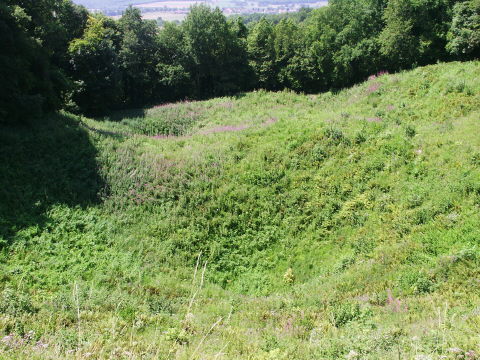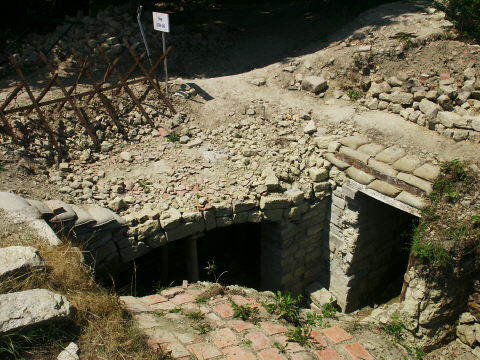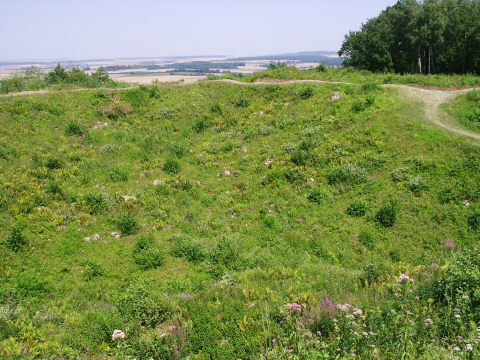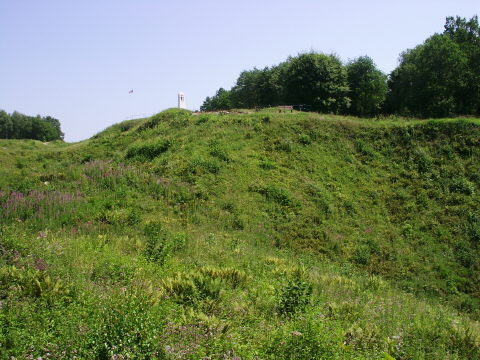Vauquois
The War Underground

To the north west of Verdun is the commanding ridge of Vauquois.
The entire area of this part of France is a series of ridges with those of Vauquois and Mort Homme guarding the valley leading down towards Verdun.

The mine torn hillside
The first time I passed Vauquois it was during the late evening en-route from the American Cemetery at Romagne to Verdun. From a photographic point of view it was the worst time of the day. Although the summer light gave some interesting shadows, the famous west mine is impossible to photograph as you are shooting directly into the sun.
These newer photos have been taken in the early afternoon, a little earlier might have been even more favourable.
 American Cemetery at Romagne-sous-Montfaucon
American Cemetery at Romagne-sous-Montfaucon
 The Battlefields of Verdun
The Battlefields of Verdun
The site is important because it is one of the few places that you can see the results of a constant mining war. Vimy is impressive but for its sheer concentration of mines and the severity of the damage caused Vauquois is hard to beat.
The Germans dig in

German shaft entrance
During their initial advances in 1914 the German army had found itself on the Butte de Vauquois on 24 September. They immediately set about turning their position into a stronghold as further west the Battles of the Marne and Aisne had resulted in the beginnings of Trench Warfare and the Race to the Sea.

Part of the German Second Line: Leichen-Gang
When they arrived on the hill the small village of Vauquois still nestled on the ridge - the modern day village has been rebuilt on the southern slope.
For five months the French tried to get a foothold on the ridge, advancing bayonets fixed in their red and blue uniforms without the benefit of artillery support. Losses were of course colossal. Eventually in the middle of March 1915 General Vaidant's 10th Division managed to hold and dig in, on the southern side of the village.
Stalemate above - Digging below
From this time onward the war at Vauquois would be fought almost entirely beneath the ground. Pioneers from both nations tunnelled and dug as they provided shelters and galleries.
On 3 February 1915 the French had blown a mine under the German lines as part of their attacks on the village.

Looking across the crest of the hill
Once the front had stabilised digging under the enemy's lines began in earnest. Thousands of tons of rock were slowly removed from the mound to make way for kilometres of galleries.
The French had the slightly harder task as they were forced to dig vertically before driving shafts under the hill. These shafts were all named after Parisian Metro Stations.

Entrance to a French shelter
The first mines that were detonated tended to be reasonably small and not very deep, the trend then moved towards ever larger and deeper mines until on 14 May 1916 the Germans detonated 60 000 kilos of explosives under the western end of the ridge. This enormous blast ripped out the entire section of the hill and killed 108 French soldiers.

The strategic importance of the hill can be seen by its height over the plain
From the middle of 1917 the French started detonating smaller but deeper mines. These camouflets were designed to destroy the German's tunnels but not rip up the landscape any further.
During the struggle for domination of the hill the French detonated 320 mines and the Germans 199. Neither side actually made any gains at all.
The Stress Factor
Today you can walk amongst the mine craters and gaze in awe at the massive hole from the May 1916 blast. It is about 80 metres across and 20 metres deep.
I count myself lucky that I did not have to spend time living in the lines of either side. The trenches are, in places, only a stones throw apart. It is beyond my understanding how anyone managed to sleep in them with the realisation that below them were soft shoed tunnellers bringing death and destruction.
In fact the stress became so bad that both sides moved towards an agreement whereby they only blew each other up in the early evenings. Despite such an agreement it is reckoned that 8,000 men who fought and died in the trenches were never found again.

Looking up from a crater towards the monument
As the mining continued the village disappeared and the landscape began to resemble something from the moon. When the American 35th Division advanced into the sector on 26 September 1918 all they found were the present day holes in the ground. The village of 168 inhabitants had long since disintegrated.

The size of some of the craters is enormous
The Lantern Tower

On top of the mound is a memorial overlooking the French lines. It is dedicated to the combatants and fallen of Vauquois. Inside is a lantern.

Carved on the rear face of the monument is a French Poilu, grenade in hand. Behind him you can see a distinctive tree which was used as a registration marker by the French artillery.
Visiting the Site
The site is now a French Heritage Site and looked after by the Friends Of Vauquois. The mine craters themselves are freely open to the public.
A car park with information boards can be found at the foot of the mound along with a few pieces from the narrow gauge railway which the French used for supplying their troops in the galleries.
Guided visits of the French and German installations take place at 09:30 hours on the first Sunday of each month and last about 90 minutes. Present yourself to the car park at the Butte.
On 1 and 8 May they hold open days from 10:00 until 17:00 hours. If there are at least 10 in the party then private visits can also be arranged.

The results of the largest mine; blown on 14 May 1916



